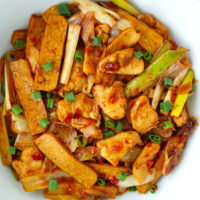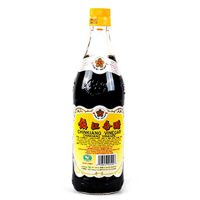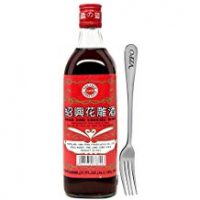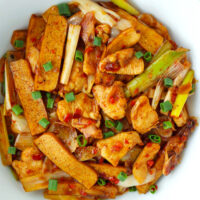 Buy Now →
Buy Now → Hoisin Chicken Stir-fry with Tofu
Tender chicken pieces, tofu strips, fragrant aromatics, and Welsh onion get tossed in an addictive and glossy savory, sweet and spicy sauce in this Hoisin Chicken Stir-fry with Tofu! Ready in under 30 minutes!
- Prep Time: 15
- Cook Time: 10
- Total Time: 25 minutes
- Yield: 4 1x
- Category: Dinner
- Method: Stir-fry
- Cuisine: Chinese
Ingredients
Scale
For the Chicken Marinade:
- 200 grams / 7 ounces Chicken Breast, boneless, skinless – cleaned, pat-dried, thinly sliced into bite-sized pieces
- ¼ TSP ground White Pepper
- ½ TSP Sesame Oil
- ½ TBLS Low Sodium Light Soy Sauce
- ½ TBLS Shao Xing Rice Wine
- 1 TSP Potato Starch (or Corn Starch)
For the Sauce:
- 2 TBLS Hoisin Sauce (I use Lee Kum Kee brand – see note 1)
- 2 TSP Low Sodium Light Soy Sauce
- 1 TBLS Shao Xing Rice Wine
- ½ TBLS Chinkiang Vinegar
- 1 TSP Sesame Oil
- 1 TSP Pure Chili Oil (optional – without flakes/seeds)
- 1 TSP Potato Starch (or Corn Starch)
- 60ml / ¼ cup Water
For the Hoisin Chicken Stir-fry with Tofu:
- 1 medium Welsh Onion (or the white part of a leek – see note 2) – sliced lengthwise, cut into 1.5-inch pieces
- 5 Garlic cloves – peeled and thinly sliced
- 1.5-inch piece of Ginger – peeled and thinly sliced (about 2 tablespoons sliced)
- 2–10 fresh Red Chilies (Thai Bird’s Eye or any small hot red chilies), to taste – finely chopped
- 2 squares (130 grams / 4.6 ounces) pressed firm Brown Tofu – thinly sliced
- 3.5 TBLS Peanut Oil (or any neutral cooking oil with a high smoke point)
- 1 TBLS Dou Ban Jiang (Chili Bean Paste – Sichuan Pixian Dou Ban Jiang preferred – see note 3)
- To Garnish (optional): Chopped Spring Onion (Scallion/Green Onion)
Instructions
Prep:
- Marinate the chicken: Clean and pat-dry the chicken breast. Slice into thin bite sized pieces. Add the chicken to a medium bowl, followed by the ground white pepper, sesame oil, low sodium light soy sauce, Shao Xing rice wine, and potato starch. Mix well to combine. Set aside to marinate for at least 15 minutes.
- Make the sauce: Mix together the hoisin sauce, low sodium light soy sauce, Shao Xing rice wine, Chinkiang vinegar, sesame oil, pure chili oil (if using), potato starch, and water in a small measuring cup (or bowl) until combined well.
- Prepare the fresh ingredients: Slice the Welsh onion, garlic, ginger, red chilies, pressed firm brown tofu as indicated in the ‘Ingredients’ section.
For the Hoisin Chicken Stir-fry with Tofu:
- Cook the chicken: Heat 3.5 tablespoons peanut oil in a large wok over high heat. Once hot, add the marinated chicken and immediately spread out the pieces in the wok. Allow to cook for 40 seconds undisturbed, then stir-fry for 20-40 seconds until the chicken is almost cooked through. Hold a fine mesh strainer above the wok and transfer the chicken pieces into it, allowing the excess oil to drip down back into the wok. Transfer the chicken to a clean bowl. Scoop out and discard crispy bits from the wok (if any).
- Sauté the aromatics: Make sure there is 3 tablespoons of oil in the wok (add more if needed) and heat over high heat. Once hot, add the dou ban jiang, garlic, ginger, and fresh red chilies. Sauté for 1 minute until fragrant.
- Cook the Welsh onion and tofu: Add the sliced Welsh onion and tofu and stir-fry for a minute to combine until the Welsh onion has softened and the tofu is slightly tender.
- Add the chicken and sauce: Give the sauce a quick stir with a spoon to loosen up the potato starch that will have settled at the bottom. Add the partially cooked chicken into the wok and pour the sauce over everything. Stir-fry for 1 minute, until the sauce thickens and coats everything well. Switch off the heat.
- To Serve: Transfer to a serving plate/dish and garnish with chopped spring onion if desired. Serve immediately with warm steamed rice.
Notes
- Hoisin Sauce: This is a dark brown thick sauce with a reddish tint. It has a savory-sweet flavor profile and is full of umami. It’s made with fermented soybeans, spices, garlic, salted red chili peppers, dried sweet potatoes, and sugar. I use Lee Kum Kee brand, but any good quality hoisin sauce will work. Find it in the Asian food aisle of mainstream supermarkets or in an Asian or Chinese supermarket.
- Welsh onion: This is a type of green onion that is similar in appearance to Western leeks. It also goes by the name of Tokyo or Japanese negi, green onion, bunching onion, and spring onion. It has more white part than the typical scallion and green onions sold in the United States. Look for it in an Asian supermarket. Substitute with the white stem part of a Western leek instead.
- Sichuan Pixian Dou Ban Jiang (Chili Bean Paste): This is a spicy chili paste/sauce that’s made with fermented broad beans, soybeans, chili peppers, salt and flour. While Lee Kum Kee produces a chili bean paste, I highly recommend using a Sichuan Pixian dou ban jiang from Chengdu, China. You can order it online (easiest way) and possibly find it in some Asian supermarkets. If using Lee Kum Kee chili bean paste, adjust the quantity to taste as it is sweeter and has several other additional ingredients.
- Asian pantry sauces: Shao Xing rice wine (Chinese cooking wine), Chinkiang vinegar (Chines black vinegar) can be found in an Asian supermarket and some mainstream supermarkets. Substitute dry sherry for Shao Xing rice wine if unavailable. Use half balsamic and half distilled white vinegar in place of Chinkiang vinegar if needed. If using regular soy sauce, half the amount as it is more salty than low sodium light soy sauce.
- See ‘Variations’ section in the post above for tips on customizing this recipe.
Nutrition
- Serving Size: 1 serving
- Calories: 287
- Sugar: 7.3g
- Sodium: 463.9mg
- Fat: 17.5g
- Saturated Fat: 2.8g
- Unsaturated Fat: 12.7g
- Trans Fat: 0g
- Carbohydrates: 16.5g
- Fiber: 2g
- Protein: 16.9g
- Cholesterol: 36.7mg
Find it online: https://thatspicychick.com/hoisin-chicken-stir-fry-with-tofu/










